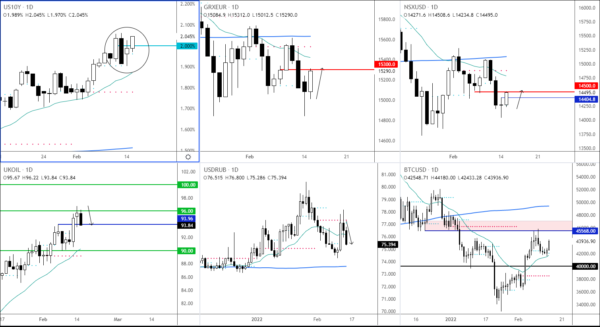… but inflation and central bank tightening remain the key risk.
The big news this morning came from Russia, which sent stocks and US futures sharply higher, while Brent crude oil dipped back to $94 after rising to above $96 earlier. The turnaround was triggered by news some Russian troops positioned on the border with Ukraine were returning to their bases after completing drills.
Source: ThinkMarkets and TradingView.com
While this will certainly help reduce tensions in the region, it doesn’t necessarily mean Russia won’t invade Ukraine. More to the point, it doesn’t necessarily mean the end of troubles for technology stocks and other sectors of the market sensitive to interest rate rises. Indeed, inflation and policy tightening remain a bigger threat to stocks.
Government bonds are unlikely to find much love any time soon. The key themes that have dominated market sentiment remains the same: inflation and central bank policy tightening. We might see government bonds stage short-covering bounces here and there, but ultimately, they remain in a bear trend as traders front-run the Fed in anticipating policy tightening. Therefore, bond yields are likely to remain in an uptrend, which, at best, should limit the potential gains for over-valued technology stocks. For the same reason, the US dollar should continue to perform well against currencies where the central banks comparatively less hawkish.
The latest sign that inflation is continuing to accelerate came from the UK as average earnings climbed to 4.3% in the 3 months to January compared to a year earlier, rising from 4.2% previously. This easily beat 3.8% expected.
We will have more US inflation pointers to look forward to this week, in the form of headline and core producer price indices later on today. PPI is expected to have risen by an additional 0.5% month-over-month in January, while core PPI is seen climbing 0.4% m/m. In addition, the FOMC’s minutes from its January meeting will be published on Wednesday, which could reveal more hawkish signals from policymakers.
So, the key question is what will happen to yields, which will, of course, have repercussions for other financial markets, not least US tech stocks. It is possible that if we see a stronger-than-expected PPI print that this will lead to further strength for yields. At around 2.0%, the 10-year yield is way lower than the 7.5% inflation rate. This means that real yields are actually -5.5%. This is bizarre, to say the least. The Fed’s QE programmes and strong foreign demand for US debt are the main reasons for this mis-match. The question is, why aren’t yields higher? Is it because the market is expecting nominal inflation rates to fall back, and quickly? Perhaps. Even if inflation falls back to around 3%, real yields would still be negative. Therefore, it is reasonable to expect yields to catch up with inflation. I reckon we will be heading towards 3.00% on the 10-year in the coming weeks, the speed of which will depend on incoming data and whether more Fed officials will turn as hawkish as Bullard. This should keep tech stocks under pressure, but support financials.
Key economic data coming up this week
Tuesday
- Eurozone quarterly GDP expected to print 0.3% q/q while employment is estimated to have risen by 1.0% q/q.
- German ZEW Economic Sentiment
- US PPI and Empire State Manufacturing Index
Wednesday
- CPI estimates from China, UK and Canada
- US retail sales, industrial productions and FOMC meeting minutes
Thursday
-
- Australian employment data
- FedSpeak: FOMC members Bullard and Mester
Friday
- Retail sales data from UK and Canada
- FedSpeak: FOMC members Waller and Williams



 Signal2forex.com - Best Forex robots and signals
Signal2forex.com - Best Forex robots and signals




